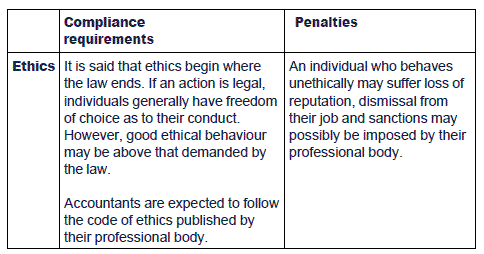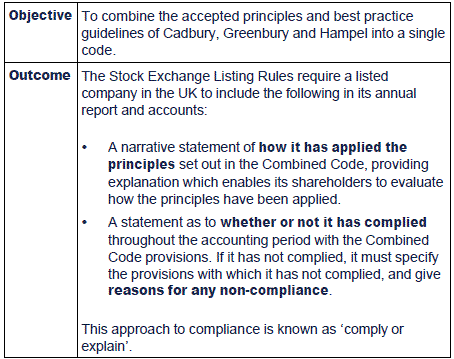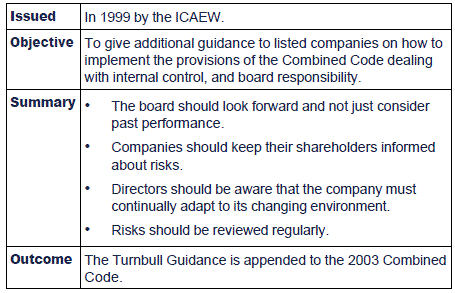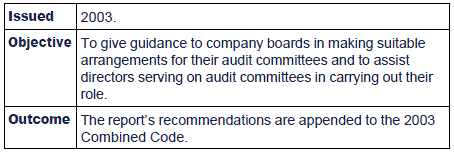Chapter 12: Corporate governance
Chapter learning objectives
Upon completion of this chapter you will be able to:
- explain the idea of corporate governance
- recognise the extra-legal codes of corporate governance
- identify and explain the legal regulation of corporate governance.
1 Introduction
Definition
 Corporate governance is the system by which companies are directed and controlled.
Corporate governance is the system by which companies are directed and controlled.
It covers topics such as:
- how power is divided between the board and the shareholders
- the accountability of the board to the members
- the rules and procedures for making decisions
- the provision of controls for companies.
Corporate governance provides the structure through which the company's objectives are met, the means of attaining those objectives and monitoring performance.
Interaction of ethics, governance and company law



 The need for corporate governance
The need for corporate governance
During the late 1980s a number of large UK public companies failed, some of them as a result of large-scale fraud by their directors.
These failures reduced public confidence in financial reporting and auditing. Many people believed that company directors regarded accounting standards as a set of rules to be circumvented and 'creative accounting' was implicated in several company liquidations:
- Directors were pressurising auditors to accept the use of 'creative accounting' schemes. As the auditors often received extra remuneration from the company for consultancy work, disagreement with the directors in the audit process could result in the loss of this additional income. This situation often compromised the auditors' independence.
- There was no clear framework for ensuring that directors reviewed internal controls in their companies.
- There was a perceived lack of accountability for excessive directors' remuneration.
A need to strengthen the systems of corporate governance used by UK companies was perceived. This need led to the establishment of the Cadbury Committee, which is considered in the next section.


 Test your understanding 1
Test your understanding 1
Which one of the following is correct?
AIt is a criminal offence for premium listed companies to fail to comply with the UK Corporate Governance Code.
BA premium listed public company has complied with the UK Corporate Governance Code if it produces a report explaining why it has not complied with its recommendations.
CThe UK Corporate Governance Code has no status and may be ignored by all companies.
DA public company may be sued for breach of statutory duty if it fails to comply with the UK Corporate Governance Code.

2 The history of corporate governance in the UK

 The Cadbury Committee
The Cadbury Committee


The 1998 Combined Code

The Turnbull Report

The Higgs Report

The Smith Report



 The role of the NEDs
The role of the NEDs
At the time of the Cadbury Report, there was a history in the UK of public companies being dominated by an all-powerful chief-executive/chairman. In addition, NEDs, where they existed at all, were often heavily outnumbered by executive directors.
The Cadbury Report recommended the separation of the roles of chief executive and chairman, although it did not state that the same person could never be both. The role of the chief executive is to take charge of the executive management and the company's business operations; the role of the chairman is to manage the board of directors.
Cadbury recommended that there should be sufficient independent NEDs for their views to carry sufficient weight. As their independence might be put at risk if they had to rely on the chairman or chief executive for their appointment, Cadbury recommended that initial interviews should be conducted through a nominations committee.
The role of the NEDs is to bring judgement and experience to the board that the executive directors might lack. In contrast to the executive directors, NEDs do not usually have a full-time relationship with the company. They are not employees and only receive directors' fees. They are expected to exert a measure of control over the executive directors to ensure that they run the company in the company's best interests (rather than their own). They should scrutinise the performance of management in meeting agreed goals and objectives and monitor the reporting of performance.
They are also responsible for determining appropriate levels of remuneration for the executive directors.
Note that as far as company law is concerned, there is no distinction between executive directors and NEDs. Both are subject to the same controls and liabilities.

3 The Combined Code on Corporate Governance
History
The Combined Code on Corporate Governance was first issued in 1998. It consisted of principles and provisions (best practice).
Revised versions of the Code were issued in 2003, 2006 and 2008. The Code consisted of main principles, supporting principles and provisions (practical requirements).
The Code was reviewed in March 2009 by the Financial Reporting Council with a consultation period and the revised Code was published in May 2010 (see below).
4 The UK Corporate Governance Code
The Code applies to financial years beginning on or after 29 June 2010.
The Code consists of main principles, supporting principles and provisions (practical requirements).
Contents
The Code is divided into five sections:
- Section A - Leadership.
- Section B - Effectiveness.
- Section C - Accountability.
- Section D - Remuneration.
- Section E - Relations with Shareholders.
The main principles of each section are outlined below, together with some of the supporting principles.
Leadership
(1)Every company should be headed by an effective board, which is collectively responsible for the long-term success of the company.
(2)There should be a clear division of responsibilities at the head of the company between the running of the board and the executive responsibility for the running of the company's business. No one individual should have unfettered powers of decision.
The supporting criteria indicate that this main principle should be met by splitting the roles of chairman and chief executive:
- the chairman should be responsible for the working of the board and the agenda for board meetings
- the chief executive should have full operational control and authority to carry out the policies determined by the board.
(3)The chairman is responsible for leadership of the board and ensuring its effectiveness on all aspects of its role.
(4)As part of their role as members of a unitary board, non-executive directors should constructively challenge and help develop proposals on strategy
Effectiveness
(1)The board and its committees should have the appropriate balance of skills, experience, independence and knowledge of the company to enable them to discharge their respective duties and responsibilities effectively. The Code provides that the board should include a balance of executive and NEDs (and in particular independent NEDs), such that no individual or small group of individuals can dominate the board's decision taking.
(2)There should be a formal, rigorous and transparent procedure for the appointment of new directors to the board.
(3)All directors should be able to allocate sufficient time to the company to discharge their responsibilities effectively.
(4)All directors should receive induction on joining the board and should regularly update and refresh their skills and knowledge.
(5)The board should be supplied in a timely manner with information in a form and of a quality appropriate to enable it to discharge its duties.
(6)The board should undertake a formal and rigorous annual evaluation of its own performance and that of its committees and individual directors.
(7)All directors should be submitted for re-election at regular intervals, subject to continued satisfactory performance.
Accountability
(1)The board should present a balanced and understandable assessment of the company's position and prospects.
(2)The board is responsible for determining the nature and extent of the significant risks it is willing to take in achieving its strategic objectives. The board should maintain sound risk management and internal control systems.
(3)The board should establish formal and transparent arrangements for considering how they should apply the corporate reporting and risk management and internal control principles and for maintaining an appropriate relationship with the company's auditor.
The Code provides that the board should establish an audit committee of at least three (or in the case of smaller companies two) members, who should all be independent non-executive directors. The board should satisfy itself that at least one member of the audit committee has recent and relevant financial experience.
The main role and responsibilities of the audit committee should be set out in written terms of reference and should include:
- monitoring the integrity of the financial statements of the company
- reviewing the company's internal financial controls and risk management systems
- monitoring and reviewing the effectiveness of the company's internal audit function
- making recommendations in relation to the appointment, re-appointment and removal of the external auditor
- reviewing and monitoring the external auditor's independence and objectivity and the effectiveness of the audit process
- developing and implementing policy on the engagement of the external auditor to supply non-audit services.
Remuneration
(1)Levels of remuneration should be sufficient to attract, retain and motivate directors of the quality required to run the company successfully, but a company should avoid paying more than is necessary for this purpose. A significant proportion of executive directors' remuneration should be structured so as to link rewards to corporate and individual performance.
(2)There should be a formal and transparent procedure for developing policy on executive remuneration and for fixing the remuneration packages of individual directors. No director should be involved in deciding his or her own remuneration.
The Code provides that service contracts and notice periods should not exceed one year.
Relations with shareholders
(1)There should be a dialogue with shareholders based on the mutual understanding of objectives. The board as a whole has responsibility for ensuring that a satisfactory dialogue with shareholders takes place.
(2)The board should use the annual general meeting (AGM) to communicate with investors and to encourage their participation.
Rules-based versus principles-based approaches to governance
The UK Corporate Governance Code is a set of principles, rather than a set of rules. It requires directors to describe in their own words the way in which they have applied the general principles of corporate governance.
A principles-based approach to governance has the following advantages and disadvantages.
Advantages
- Because the directors report on the actual circumstances of their own company, the report should be more meaningful than one based on specific detailed requirements.
- A code of practice can be changed much more easily than statutory requirements. This means that the Code can be updated to respond to changing conditions and changing expectations of shareholders and others.
- A principles-based approach encourages the directors to follow the spirit of the Code, whereas a rules-based approach may result in a tick-boxes mentality. This means that under a rules-based approach the directors may follow the letter of the rules, rather than their spirit.
Disadvantages
- A principles-based approach tends to result in general, meaningless statements.
- It may be difficult for the directors to see whether they have met the specific requirements of the Code.

 Test your understanding 2
Test your understanding 2
ADefine the term 'corporate governance'. (Your answer must not exceed 15 words.)
BComplete the gaps. The following persons cannot be regarded as independent:
- anyone who has been an employee of the company in the previous ……years.
- anyone who has had a material business relationship with the company in the previous ……years.
- anyone who has served on the board for more than ……years.
C.Complete the following sentence in no more than 20 words:
The UK Stock Exchange rules require premium listed companies to comply with the UK Corporate Governance Code. If it does not comply, the company must…

5 The legal regulation of corporate governance
Introduction
The legislation covering corporate governance has been covered in earlier chapters. The following table gives you an indication of where to find the relevant provisions:


The Sarbanes-Oxley Act 2002
The Sarbanes-Oxley Act 2002 is a US law that applies to all companies (including foreign companies) that have a listing on the US stock exchange.
It was introduced in the wake of corporate scandals such as the unexpected collapse of Enron and WorldCom.
The US approach to corporate governance is a statutory rules-based one. This differs from the UK where it is principles-based with an emphasis on voluntary compliance. The Sarbanes-Oxley Act requires all companies with a listing in the US to include in their annual report a certificate vouching for the accuracy of the financial statements. This certificate must be signed by the company's principal executive officer and principal financial officer.

 Test your understanding 3
Test your understanding 3
AWhat is the maximum permitted length of a director's service contract according to:
Ithe Companies Act 2006
II the UK Corporate Governance Code?
BTo which companies does the Sarbanes-Oxley Act apply?

6 Chapter summary
Test your understanding answers

 Test your understanding 1
Test your understanding 1
BThe UK Corporate Governance Code is not legislation. It is therefore not mandatory. Companies are required to either comply with the Code or explain why they have not done so. Therefore a company which explains why it has not complied with the Code's recommendations would nonetheless be complying with it!


 Test your understanding 2
Test your understanding 2
A Corporate governance is the system by which companies are directed and controlled.
B The following individuals cannot be regarded as independent:
- anyone who has been an employee of the company in the previous five years
- anyone who has had a material business relationship with the company in the previous three years
- anyone who has served on the board for more than nine years.
C.The Stock Exchange rules require premium listed companies to comply with the UK Corporate Governance Code. If it does not comply, the company must specify the provisions with which it has not complied, and give reasons for its non-compliance


 Test your understanding 3
Test your understanding 3
AThe maximum permitted length of a director's service contract is:
Itwo years according to the Companies Act 2006
II one year according to the UK Corporate Governance Code.
BThe Sarbanes-Oxley Act applies to all companies (including foreign companies) that have a listing on the US stock exchange.

|
Created at 5/24/2012 3:23 PM by System Account
(GMT) Greenwich Mean Time : Dublin, Edinburgh, Lisbon, London
|
Last modified at 8/21/2012 3:59 PM by System Account
(GMT) Greenwich Mean Time : Dublin, Edinburgh, Lisbon, London
|
|
|
|
 |
Rating
:
|
 Ratings & Comments
(Click the stars to rate the page) Ratings & Comments
(Click the stars to rate the page)
|
 |
Tags:
|
|
|
|
|